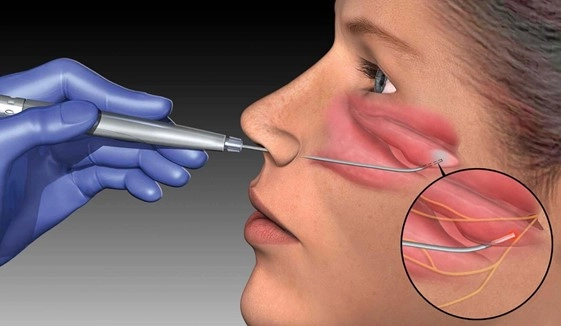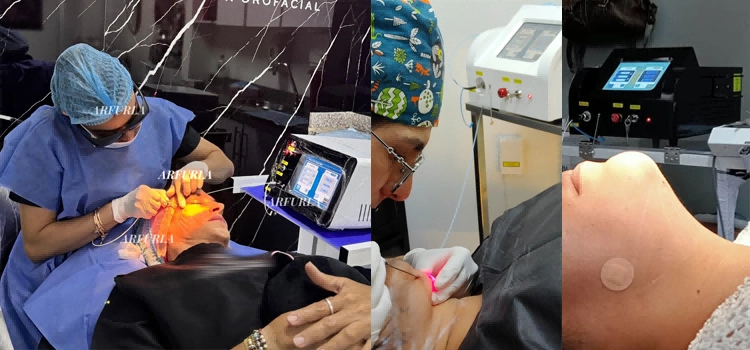980nm diode laser machine for Vascular removal Spider vein removal laser treatment for Face Vein blood vessels facial redness removal and capillary varicose telangiectasia

The 980nm diode laser spider vein removal method works by targeting the hemoglobin in blood vessels with a specific wavelength of light. This laser’s energy is absorbed by the hemoglobin, causing the blood vessel to heat up and coagulate. The treated vein then collapses and is gradually absorbed by the body, effectively removing the spider vein.
What types of blood vessels can be used?
1. Hereditary or congenital telangiectasia
Applicable to facial red blood streaks caused by family heredity. Laser can accurately close dilated blood vessels and reduce skin redness.
2. Red blood streaks related to rosacea
Applicable to facial flushing, persistent erythema and telangiectasia caused by rosacea. Laser can reduce inflammatory response and shrink abnormal blood vessels.
3. Red blood streaks caused by sun exposure or environmental stimulation
Long-term ultraviolet damage or extreme temperature changes (such as alternating hot and cold) may cause skin blood vessels to dilate. Laser can repair damaged blood vessels and reduce redness.
4. Red blood streaks associated with sensitive skin or weak stratum corneum
Applicable to the problem of easy dilation of blood vessels caused by damaged skin barrier. After laser treatment, repair skin care products can be used to enhance skin resistance.
5. Vascular dilation after hormone-dependent dermatitis
Long-term use of hormone ointments may cause thinning of the skin and dilation of blood vessels. Laser can help close abnormal blood vessels.


Key Advantages of 980 nm Diode Laser spider veins removal?
- Optimal Selectivity for Hemoglobin
The 980 nm wavelength is highly absorbed by hemoglobin in blood vessels, enabling precise targeting of spider veins with minimal impact on surrounding tissue
This selective absorption leads to efficient coagulation and natural clearance of veins
- Deeper Penetration + High Precision
Offers a perfect balance: deep enough to address deeper vessels, yet focused enough to safeguard nearby skin
Small spot sizes (0.7-2.5mm adjustable) ensure concentrated energy delivery only to target vessels
- Minimized Side Effects & Scarring
Precisely focused energy reduces risk of burning, redness, and scarring, far gentler than traditional surgery
Non‑invasive: no incisions, no bleeding, and greatly reduced recovery concerns
- Stimulates Collagen & Skin Regeneration
During vein removal, it also promotes dermal collagen growth, thickens the epidermis, and enhances skin elasticity, leading to overall skin improvement
- Fast, Comfortable, Outpatient-Friendly
Treatments are quick (typically 15–30 minutes), with minimal discomfort, often described as a slight snapping or warming sensation
- Few Sessions & Long‑Lasting Results
Many patients see major improvement after just 1–2 sessions, and the results tend to be more permanent than those with traditional methods
Using a 980 nm diode laser for spider vein removal offers:
Targeted, hemoglobin-focused energy
Controlled penetration with precise spot targeting
Minimal pain, bleeding, scarring, and downtime
Collagen-inducing, skin-enhancing benefits
Quick, usually 1–2 sessions with long-lasting results


FAQ
- Is it painful?
During the treatment, the heat may stimulate the nerve endings of the skin, causing a brief discomfort, but this stimulation is usually limited to the moment of treatment. Slight tingling may be slightly noticeable in sensitive areas such as the face.
- How to take care of yourself after treatment
- Moisturizing is important: Apply medical moisturizing cream/gel 2-3 times a day to keep the skin moisturized and avoid dryness and desquamation
- Avoid makeup within 1 month after treatment. If you need to cover up, you can use medical concealer under the guidance of a doctor.
- Avoid spicy, hot foods and alcohol, which may induce facial vasodilation
- Reduce staying up late and avoid excessive emotional tension
- Is redness and swelling normal?
Slight redness and swelling after surgery is a common normal reaction.
For most people, it will gradually subside within 1-3 days. For a few people with sensitive skin or thick blood vessels in the treatment area, it may last for 5-7 days, but it will gradually subside.




